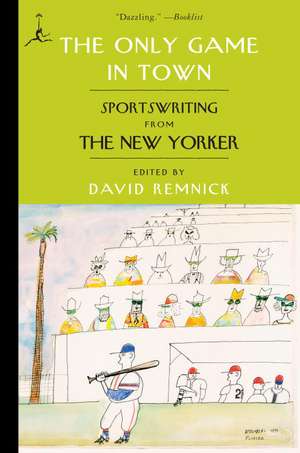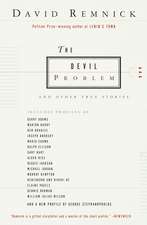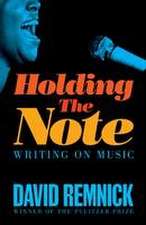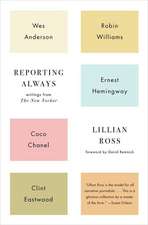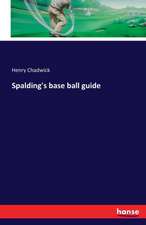The Only Game in Town: Sportswriting from the New Yorker: Modern Library (Paperback)
Editat de David Remnicken Limba Engleză Paperback – 31 mai 2011
Din seria Modern Library (Paperback)
-
 Preț: 129.93 lei
Preț: 129.93 lei -
 Preț: 90.25 lei
Preț: 90.25 lei -
 Preț: 124.55 lei
Preț: 124.55 lei -
 Preț: 120.25 lei
Preț: 120.25 lei -
 Preț: 112.74 lei
Preț: 112.74 lei -
 Preț: 169.74 lei
Preț: 169.74 lei -
 Preț: 108.33 lei
Preț: 108.33 lei -
 Preț: 100.57 lei
Preț: 100.57 lei -
 Preț: 155.91 lei
Preț: 155.91 lei -
 Preț: 142.38 lei
Preț: 142.38 lei -
 Preț: 142.79 lei
Preț: 142.79 lei -
 Preț: 133.47 lei
Preț: 133.47 lei -
 Preț: 126.88 lei
Preț: 126.88 lei -
 Preț: 134.93 lei
Preț: 134.93 lei -
 Preț: 120.07 lei
Preț: 120.07 lei -
 Preț: 119.74 lei
Preț: 119.74 lei -
 Preț: 104.02 lei
Preț: 104.02 lei -
 Preț: 122.76 lei
Preț: 122.76 lei -
 Preț: 119.36 lei
Preț: 119.36 lei -
 Preț: 112.33 lei
Preț: 112.33 lei - 18%
 Preț: 97.51 lei
Preț: 97.51 lei -
 Preț: 137.09 lei
Preț: 137.09 lei -
 Preț: 103.26 lei
Preț: 103.26 lei
Preț: 107.35 lei
Nou
Puncte Express: 161
Preț estimativ în valută:
20.54€ • 21.52$ • 16.98£
20.54€ • 21.52$ • 16.98£
Carte disponibilă
Livrare economică 22 martie-05 aprilie
Livrare express 08-14 martie pentru 37.10 lei
Preluare comenzi: 021 569.72.76
Specificații
ISBN-13: 9780812979985
ISBN-10: 0812979982
Pagini: 492
Ilustrații: ILLUSTRATIONS THROUGHOUT
Dimensiuni: 155 x 234 x 30 mm
Greutate: 0.66 kg
Editura: Modern Library
Seria Modern Library (Paperback)
ISBN-10: 0812979982
Pagini: 492
Ilustrații: ILLUSTRATIONS THROUGHOUT
Dimensiuni: 155 x 234 x 30 mm
Greutate: 0.66 kg
Editura: Modern Library
Seria Modern Library (Paperback)
Notă biografică
David Remnick has been the editor of The New Yorker since 1998. A staff writer for the magazine from 1992 to 1998, he was previously The Washington Post's correspondent in the Soviet Union. The author of several books, he was awarded the Pulitzer Prize and the George Polk Award for his 1994 book Lenin's Tomb. He lives in New York with his wife and children.
Extras
PART ONE
FROM THE BLEACHERS
THE WEB OF THE GAME
ROGER ANGELL
An afternoon in mid-May, and we are waiting for the game to begin. We are in shadow, and the sunlit field before us is a thick, springy green —an old diamond, beautifully kept up. The grass continues beyond the low chain-link fence that encloses the outfield, extending itself on the right-field side into a rougher, featureless sward that terminates in a low line of distant trees, still showing a pale, early-summer green. We are almost in the country. Our seats are in the seventh row of the grandstand, on the home side of the diamond, about halfway between third base and home plate. The seats themselves are more comforting to spirit than to body, being a surviving variant example of the pure late-Doric Polo Grounds mode: the backs made of a continuous running row of wood slats, divided off by pairs of narrow cast-iron arms, within which are slatted let-down seats, grown arthritic with rust and countless layers of gray paint. The rows are stacked so closely upon each other (one discovers) that a happening on the field of sufficient interest to warrant a rise or half-rise to one’s feet is often made more memorable by a sharp crack to the kneecaps delivered by the backs of the seats just forward; in time, one finds that a dandruff of gray paint flakes from the same source has fallen on one’s lap and scorecard. None of this matters, for this view and these stands and this park—it is Yale Field, in New Haven—are renowned for their felicity. The grandstand is a low, penumbrous steel- post shed that holds the infield in a pleasant horseshoe-curved embrace. The back wall of the grandstand, behind the uppermost row of seats, is broken by an arcade of open arches, admitting a soft backlight that silhouettes the upper audience and also discloses an overhead bonework of struts and beams supporting the roof—the pigeonland of all the ballparks of our youth. The game we are waiting for—Yale vs. St. John’s University—is a considerable event, for it is part of the National Collegiate Athletic Association’s northeast regional tournament, the winner of which will qualify for a berth at the national collegiate championships in Omaha in June, the World Series of college baseball. Another pair of teams, Maine and Central Michigan—the Black Bears and the Chippewas—have just finished their game here, the first of a doubleheader. Maine won it, 10–2, but the ultimate winner will not be picked here for three more days, when the four teams will have completed a difficult double-elimination tournament. Good, hard competition, but the stands at Yale Field are half empty today. Call them half full, because everyone on hand—some twenty-five hundred fans—must know something about the quality of the teams here, or at least enough to qualify either as a partisan or as an expert, which would explain the hum of talk and expectation that runs through the grandstand even while the Yale team, in pinstriped home whites, is still taking infield practice.
I am seated in a little sector of senior New Haven men—Townies rather than Old Elis. One of them a couple of rows in front of me says, “They used to fill this place in the old days, before there was all the baseball on TV.”
His neighbor, a small man in a tweed cap, says, “The biggest crowd I ever saw in here—the biggest ever, I bet—was for a high school game. Shelton and Naugatuck, about twenty years ago.”
An old gent with a cane, seated just to my left, says, “They filled it up that day the Yankees came here, with Ruth and Gehrig and the rest of them. An exhibition game.”
A fan just beyond the old gentleman—a good-looking man in his sixties, with an open, friendly face, a large smile, and a thick stand of gray hair—leans toward my neighbor and says, “When was that game, Joe? 1930? 1932?”
“Oh, I can’t remember,” the old man says. “Somewhere in there. My youngest son was mascot for the Yankees that day, so I could figure it out, I suppose.” He is not much interested. His eyes are on the field. “Say, look at these fellows throw!” he says. “Did you see that outfielder peg in the ball?”
“That was the day Babe Ruth said this was about the best-looking ballpark he’d ever ever seen,” the man beyond says. “You remember that.”
“I can remember long before this park was built,” the old man says. “It was already the Yale ballfield when I got here, but they put in these stands later— Who is this shortstop? He’s a hefty-looking bird.”
“How many Yale games do you think you’ve seen, Joe?” the smiling man asks.
“Oh, I couldn’t begin to count them. But I haven’t seen a Yale team play in— I don’t know how long. Not for years. These fellows today, they play in the Cape Cod League in the summers. They let the freshmen play here now, too. They recruit them more, I suppose. They’re athletes —you can see that.”
The Yale team finishes its warmup ritual, and St. John’s—light gray uniforms with scarlet cap bills and scarlet socks—replaces it on the field.
“St. John’s has always had a good club,” the old man tells me. “Even back when my sons were playing ball, it was a good ball team. But not as good as this one. Oh, my! Did you see this catcher throw down to second? Did you see that! I bet you in all the years I was here I didn’t have twenty fellows who could throw.”
“Your sons played here?” I ask him. “For Yale?”
“My son Joe was captain in ’41,” he says. “He was a pitcher. He pitched against my son Steve here one day. Steve was pitching for Colgate, and my other son, Bob—my youngest—was on the same Colgate team. A good little left-handed first baseman.”
I am about to ask how that game turned out, but the old man has taken out a small gold pocket watch, with a hunting case, which he snaps open. Three-fourteen. “Can’t they get this started?” he says impatiently.
I say something admiring about the watch, and he hands it to me carefully. “I’ve had that watch for sixty-eight years,” he says. “I always carried it in my vest pocket, back when we wore vests.”
The little watch has a considerable heft to it: a weight of authority. I turn it over and find an inscription on the back. It is in script and a bit worn, but I can still make it out:
Presented to Joe Wood
by his friend A. E. Smith
in appreciation of his splendid
pitching which brought the
world’s championship
to Boston in 1912.
“Who was A. E. Smith, Mr. Wood?” I ask.
“He was a manufacturer.”
I know the rest. Joe Wood, the old gentleman on my left, was the baseball coach at Yale for twenty years—from 1923 to 1942. Before that, he was a sometime outfielder for the Cleveland Indians, who batted .366 in 1921. Before that, he was a celebrated right-handed pitcher for the Boston Red Sox—Smokey Joe Wood, who won thirty-four games for the Bosox in 1912, when he finished up with a record of 34-5, pitching ten shutouts and sixteen consecutive victories along the way. In the World Series that fall—one of the two or three finest ever played—he won three of the four games he pitched, including the famous finale: the game of Hooper’s catch and Snodgrass’s muff and Tris Speaker’s killing tenth-inning single. Next to Walter Johnson, Smokey Joe Wood was the most famous fastballer of his era. Still is, no doubt, in the minds of the few surviving fans who saw him at his best. He is ninety-one years old.
None of this, I should explain—neither my presence at the game nor my companions in the stands—was an accident. I had been a fervent admirer of Smokey Joe Wood ever since I read his account of his baseball beginnings and his subsequent career in Lawrence Ritter’s The Glory of Their Times, a cherished, classic volume of oral history of the early days of the pastime. Mr. Wood was in his seventies when that book was published, in 1966, and I was startled and pleased a few weeks ago when I ran across an article by Joan Whaley, in Baseball Digest, which informed me that he was still hale and still talking baseball in stimulating fashion. He was living with a married daughter in New Haven, and my first impulse was to jump in my car and drive up to press a call. But something held me back; it did not seem quite right to present myself uninvited at his door, even as a pilgrim. Then Ron Darling and Frank Viola gave me my chance. Darling, who was a junior at Yale this past year, is the best pitcher ever to take the mound for the Blue. He is better than Johnny Broaca, who went on to pitch for the Yankees and the Indians for five seasons in the mid-1930s; he is better than Frank Quinn, who compiled a 1.57 career earned-run average at Yale in 1946, ’47, and ’48. (He is also a better all-around ballplayer than George Bush, who played first base and captained the Elis in 1948, and then somehow drifted off into politics instead of baseball.) Darling, a right-handed fastball thrower, won eleven games and lost two as a sophomore, with an earned-run average of 1.31, and this year he was 9-3 and 2.42, with eighty-nine strikeouts in his ninety-three innings of work—the finest college pitcher in the Northeast, according to major-league scouts, with the possible exception of Frank Viola, a junior left-handed curveball ace at St. John’s, who was undefeated this year, 9-0, and had a neat earned-run average of 1.00. St. John’s, a Catholic university in Queens, is almost a baseball powerhouse—not quite in the same class, perhaps, as such perennial national champions or challengers as Arizona, Arizona State, UCLA, and Southern California, whose teams play Sun Belt schedules of close to sixty games, but good enough to have gone as the Northeast’s representative to the national tournament in Omaha in 1980, where Viola defeated the eventual winner, Arizona, in the first round. St. John’s, by the way, does not recruit high school stars from faraway states, as do most of these rival college powers; all but one player on this year’s thirty-three-man Redmen squad grew up and went to school in New York City or in nearby suburbs. This 1981 St. John’s team ran off an awesome 31-2 record, capturing the Eastern College Metro (Greater New York, that is) elimination, while Yale, winning its last nine games in a row, concluded its regular season with a record of 24-12-1, which was good enough to win its first Eastern Intercollegiate League championship since 1956. (That tie in Yale’s record was a game against the University of Central Florida, played during the Elis’ spring-training tour in March, and was called because of darkness after seven innings, with the score tied at 21–21. Darling did not pitch that day.) The two teams, along with Central Michigan (Mid-America Conference) and Maine (New England Conference), qualified for the tournament at New Haven, and the luck of the draw pitted Yale (and Darling) against St. John’s (and Viola) in the second game of the opening doubleheader. Perfect. Darling, by the way, had indicated that he might be willing to turn professional this summer if he were to be picked in an early round of the annual amateur draft conducted by the major leagues in mid-June, and Viola had been talked about as a potential big-leaguer ever since his freshman year, so their matchup suddenly became an obligatory reunion for every front-rank baseball scout east of the Ohio River. (About fifty of them turned up, with their speed-guns and clipboards, and their glowing reports of the game, I learned later, altered the draft priorities of several clubs.)
Perfect, but who would get in touch with Mr. Wood and persuade him to come out to Yale Field with me for the game? Why, Dick Lee would—Dick Lee, of course. Richard C. Lee (he was the smiling man sitting just beyond Smokey Joe in our row) is a former Democratic mayor of New Haven, an extremely popular (eight consecutive terms, sixteen years in office), innovative officeholder who, among other things, presided over the widely admired urban renewal of his city during the 1960s and, before that, thought up and pushed through the first Operation Head Start program (for minority-group preschoolers) in the country. Dick Lee knows everybody in New Haven, including Smokey Joe Wood and several friends of mine there, one of whom provided me with his telephone number. I called Lee at his office (he is assistant to the chairman of the Union Trust Company, in New Haven) and proposed our party. “Wonderful!” he cried at once. “You have come to the right man. I’ll bring Joe. Count on me!” Even over the telephone, I could see him smiling.
Dick Lee did not play baseball for Yale, but the nature of his partisanship became clear in the very early moments of the Yale–St. John’s game. “Yay!” he shouted in a stentorian baritone as Ron Darling set down three St. John’s batters in order in the first. “Yay, Ron baby!” he boomed out as Darling dismissed three more batters in the second, fanning the last two. “Now c’mon, Yale! Let’s get something started, gang! Yay!” Lee had told me that he pitched for some lesser- known New Haven teams—the Dixwell Community House sandlot team and the Jewish Home for Children nine (the Utopians), among others—while he was growing up in the ivyless New Hallville neighborhood. Some years later, having passed up college altogether, he went to work for Yale as its public-relations officer. By the time he became mayor, in 1953, the university was his own—another precinct to be worried about and looked after. A born politician, he appears to draw on some inner deep- water reservoir of concern that enables him to preside effortlessly and affectionately over each encounter of his day; he was the host at our game, and at intervals he primed Joe Wood with questions about his baseball past, which he seemed to know almost by heart.
“Yes, that’s right, I did play for the Bloomer Girls a few games,” Mr. Wood said in response to one such cue. “I was about sixteen, and I was pitching for our town team in Ness City, Kansas. The Bloomer Girls were a barnstorming team, but they used to pick up a few young local fellows on the sly to play along with them if they needed to fill out their lineup. I was one of those. I never wore a wig, though—I wouldn’t have done that. I guess I looked young enough to pass for a girl anyway. Bill Stern, the old radio broadcaster, must have used that story about forty times, but he always got it wrong about the wig.”
There was a yell around us, and an instantly ensuing groan, as Yale’s big freshman catcher, Tony Paterno, leading off the bottom of the second, lined sharply to the St. John’s shortstop, who made a fine play on the ball. Joe Wood peered intently out at the field through his thickish horn-rimmed spectacles. He shook his head a little. “You know, I can’t hardly follow the damned ball now,” he said. “It’s better for me if I’m someplace where I can get up high behind the plate. I was up to Fenway Park for two games last year, and they let me sit in the press box there at that beautiful park. I could see it all from there. The groundskeeper has got that field just like a living room.”
I asked him if he still rooted for the Red Sox.
“Oh, yes,” he said. “All my life. A couple of years ago, when they had that big lead in the middle of the summer, they asked me if I’d come up and throw out the first ball at one of their World Series games or playoff games. But then they dropped out of it, of course. Now it looks like it’ll never happen.”
From the Hardcover edition.
FROM THE BLEACHERS
THE WEB OF THE GAME
ROGER ANGELL
An afternoon in mid-May, and we are waiting for the game to begin. We are in shadow, and the sunlit field before us is a thick, springy green —an old diamond, beautifully kept up. The grass continues beyond the low chain-link fence that encloses the outfield, extending itself on the right-field side into a rougher, featureless sward that terminates in a low line of distant trees, still showing a pale, early-summer green. We are almost in the country. Our seats are in the seventh row of the grandstand, on the home side of the diamond, about halfway between third base and home plate. The seats themselves are more comforting to spirit than to body, being a surviving variant example of the pure late-Doric Polo Grounds mode: the backs made of a continuous running row of wood slats, divided off by pairs of narrow cast-iron arms, within which are slatted let-down seats, grown arthritic with rust and countless layers of gray paint. The rows are stacked so closely upon each other (one discovers) that a happening on the field of sufficient interest to warrant a rise or half-rise to one’s feet is often made more memorable by a sharp crack to the kneecaps delivered by the backs of the seats just forward; in time, one finds that a dandruff of gray paint flakes from the same source has fallen on one’s lap and scorecard. None of this matters, for this view and these stands and this park—it is Yale Field, in New Haven—are renowned for their felicity. The grandstand is a low, penumbrous steel- post shed that holds the infield in a pleasant horseshoe-curved embrace. The back wall of the grandstand, behind the uppermost row of seats, is broken by an arcade of open arches, admitting a soft backlight that silhouettes the upper audience and also discloses an overhead bonework of struts and beams supporting the roof—the pigeonland of all the ballparks of our youth. The game we are waiting for—Yale vs. St. John’s University—is a considerable event, for it is part of the National Collegiate Athletic Association’s northeast regional tournament, the winner of which will qualify for a berth at the national collegiate championships in Omaha in June, the World Series of college baseball. Another pair of teams, Maine and Central Michigan—the Black Bears and the Chippewas—have just finished their game here, the first of a doubleheader. Maine won it, 10–2, but the ultimate winner will not be picked here for three more days, when the four teams will have completed a difficult double-elimination tournament. Good, hard competition, but the stands at Yale Field are half empty today. Call them half full, because everyone on hand—some twenty-five hundred fans—must know something about the quality of the teams here, or at least enough to qualify either as a partisan or as an expert, which would explain the hum of talk and expectation that runs through the grandstand even while the Yale team, in pinstriped home whites, is still taking infield practice.
I am seated in a little sector of senior New Haven men—Townies rather than Old Elis. One of them a couple of rows in front of me says, “They used to fill this place in the old days, before there was all the baseball on TV.”
His neighbor, a small man in a tweed cap, says, “The biggest crowd I ever saw in here—the biggest ever, I bet—was for a high school game. Shelton and Naugatuck, about twenty years ago.”
An old gent with a cane, seated just to my left, says, “They filled it up that day the Yankees came here, with Ruth and Gehrig and the rest of them. An exhibition game.”
A fan just beyond the old gentleman—a good-looking man in his sixties, with an open, friendly face, a large smile, and a thick stand of gray hair—leans toward my neighbor and says, “When was that game, Joe? 1930? 1932?”
“Oh, I can’t remember,” the old man says. “Somewhere in there. My youngest son was mascot for the Yankees that day, so I could figure it out, I suppose.” He is not much interested. His eyes are on the field. “Say, look at these fellows throw!” he says. “Did you see that outfielder peg in the ball?”
“That was the day Babe Ruth said this was about the best-looking ballpark he’d ever ever seen,” the man beyond says. “You remember that.”
“I can remember long before this park was built,” the old man says. “It was already the Yale ballfield when I got here, but they put in these stands later— Who is this shortstop? He’s a hefty-looking bird.”
“How many Yale games do you think you’ve seen, Joe?” the smiling man asks.
“Oh, I couldn’t begin to count them. But I haven’t seen a Yale team play in— I don’t know how long. Not for years. These fellows today, they play in the Cape Cod League in the summers. They let the freshmen play here now, too. They recruit them more, I suppose. They’re athletes —you can see that.”
The Yale team finishes its warmup ritual, and St. John’s—light gray uniforms with scarlet cap bills and scarlet socks—replaces it on the field.
“St. John’s has always had a good club,” the old man tells me. “Even back when my sons were playing ball, it was a good ball team. But not as good as this one. Oh, my! Did you see this catcher throw down to second? Did you see that! I bet you in all the years I was here I didn’t have twenty fellows who could throw.”
“Your sons played here?” I ask him. “For Yale?”
“My son Joe was captain in ’41,” he says. “He was a pitcher. He pitched against my son Steve here one day. Steve was pitching for Colgate, and my other son, Bob—my youngest—was on the same Colgate team. A good little left-handed first baseman.”
I am about to ask how that game turned out, but the old man has taken out a small gold pocket watch, with a hunting case, which he snaps open. Three-fourteen. “Can’t they get this started?” he says impatiently.
I say something admiring about the watch, and he hands it to me carefully. “I’ve had that watch for sixty-eight years,” he says. “I always carried it in my vest pocket, back when we wore vests.”
The little watch has a considerable heft to it: a weight of authority. I turn it over and find an inscription on the back. It is in script and a bit worn, but I can still make it out:
Presented to Joe Wood
by his friend A. E. Smith
in appreciation of his splendid
pitching which brought the
world’s championship
to Boston in 1912.
“Who was A. E. Smith, Mr. Wood?” I ask.
“He was a manufacturer.”
I know the rest. Joe Wood, the old gentleman on my left, was the baseball coach at Yale for twenty years—from 1923 to 1942. Before that, he was a sometime outfielder for the Cleveland Indians, who batted .366 in 1921. Before that, he was a celebrated right-handed pitcher for the Boston Red Sox—Smokey Joe Wood, who won thirty-four games for the Bosox in 1912, when he finished up with a record of 34-5, pitching ten shutouts and sixteen consecutive victories along the way. In the World Series that fall—one of the two or three finest ever played—he won three of the four games he pitched, including the famous finale: the game of Hooper’s catch and Snodgrass’s muff and Tris Speaker’s killing tenth-inning single. Next to Walter Johnson, Smokey Joe Wood was the most famous fastballer of his era. Still is, no doubt, in the minds of the few surviving fans who saw him at his best. He is ninety-one years old.
None of this, I should explain—neither my presence at the game nor my companions in the stands—was an accident. I had been a fervent admirer of Smokey Joe Wood ever since I read his account of his baseball beginnings and his subsequent career in Lawrence Ritter’s The Glory of Their Times, a cherished, classic volume of oral history of the early days of the pastime. Mr. Wood was in his seventies when that book was published, in 1966, and I was startled and pleased a few weeks ago when I ran across an article by Joan Whaley, in Baseball Digest, which informed me that he was still hale and still talking baseball in stimulating fashion. He was living with a married daughter in New Haven, and my first impulse was to jump in my car and drive up to press a call. But something held me back; it did not seem quite right to present myself uninvited at his door, even as a pilgrim. Then Ron Darling and Frank Viola gave me my chance. Darling, who was a junior at Yale this past year, is the best pitcher ever to take the mound for the Blue. He is better than Johnny Broaca, who went on to pitch for the Yankees and the Indians for five seasons in the mid-1930s; he is better than Frank Quinn, who compiled a 1.57 career earned-run average at Yale in 1946, ’47, and ’48. (He is also a better all-around ballplayer than George Bush, who played first base and captained the Elis in 1948, and then somehow drifted off into politics instead of baseball.) Darling, a right-handed fastball thrower, won eleven games and lost two as a sophomore, with an earned-run average of 1.31, and this year he was 9-3 and 2.42, with eighty-nine strikeouts in his ninety-three innings of work—the finest college pitcher in the Northeast, according to major-league scouts, with the possible exception of Frank Viola, a junior left-handed curveball ace at St. John’s, who was undefeated this year, 9-0, and had a neat earned-run average of 1.00. St. John’s, a Catholic university in Queens, is almost a baseball powerhouse—not quite in the same class, perhaps, as such perennial national champions or challengers as Arizona, Arizona State, UCLA, and Southern California, whose teams play Sun Belt schedules of close to sixty games, but good enough to have gone as the Northeast’s representative to the national tournament in Omaha in 1980, where Viola defeated the eventual winner, Arizona, in the first round. St. John’s, by the way, does not recruit high school stars from faraway states, as do most of these rival college powers; all but one player on this year’s thirty-three-man Redmen squad grew up and went to school in New York City or in nearby suburbs. This 1981 St. John’s team ran off an awesome 31-2 record, capturing the Eastern College Metro (Greater New York, that is) elimination, while Yale, winning its last nine games in a row, concluded its regular season with a record of 24-12-1, which was good enough to win its first Eastern Intercollegiate League championship since 1956. (That tie in Yale’s record was a game against the University of Central Florida, played during the Elis’ spring-training tour in March, and was called because of darkness after seven innings, with the score tied at 21–21. Darling did not pitch that day.) The two teams, along with Central Michigan (Mid-America Conference) and Maine (New England Conference), qualified for the tournament at New Haven, and the luck of the draw pitted Yale (and Darling) against St. John’s (and Viola) in the second game of the opening doubleheader. Perfect. Darling, by the way, had indicated that he might be willing to turn professional this summer if he were to be picked in an early round of the annual amateur draft conducted by the major leagues in mid-June, and Viola had been talked about as a potential big-leaguer ever since his freshman year, so their matchup suddenly became an obligatory reunion for every front-rank baseball scout east of the Ohio River. (About fifty of them turned up, with their speed-guns and clipboards, and their glowing reports of the game, I learned later, altered the draft priorities of several clubs.)
Perfect, but who would get in touch with Mr. Wood and persuade him to come out to Yale Field with me for the game? Why, Dick Lee would—Dick Lee, of course. Richard C. Lee (he was the smiling man sitting just beyond Smokey Joe in our row) is a former Democratic mayor of New Haven, an extremely popular (eight consecutive terms, sixteen years in office), innovative officeholder who, among other things, presided over the widely admired urban renewal of his city during the 1960s and, before that, thought up and pushed through the first Operation Head Start program (for minority-group preschoolers) in the country. Dick Lee knows everybody in New Haven, including Smokey Joe Wood and several friends of mine there, one of whom provided me with his telephone number. I called Lee at his office (he is assistant to the chairman of the Union Trust Company, in New Haven) and proposed our party. “Wonderful!” he cried at once. “You have come to the right man. I’ll bring Joe. Count on me!” Even over the telephone, I could see him smiling.
Dick Lee did not play baseball for Yale, but the nature of his partisanship became clear in the very early moments of the Yale–St. John’s game. “Yay!” he shouted in a stentorian baritone as Ron Darling set down three St. John’s batters in order in the first. “Yay, Ron baby!” he boomed out as Darling dismissed three more batters in the second, fanning the last two. “Now c’mon, Yale! Let’s get something started, gang! Yay!” Lee had told me that he pitched for some lesser- known New Haven teams—the Dixwell Community House sandlot team and the Jewish Home for Children nine (the Utopians), among others—while he was growing up in the ivyless New Hallville neighborhood. Some years later, having passed up college altogether, he went to work for Yale as its public-relations officer. By the time he became mayor, in 1953, the university was his own—another precinct to be worried about and looked after. A born politician, he appears to draw on some inner deep- water reservoir of concern that enables him to preside effortlessly and affectionately over each encounter of his day; he was the host at our game, and at intervals he primed Joe Wood with questions about his baseball past, which he seemed to know almost by heart.
“Yes, that’s right, I did play for the Bloomer Girls a few games,” Mr. Wood said in response to one such cue. “I was about sixteen, and I was pitching for our town team in Ness City, Kansas. The Bloomer Girls were a barnstorming team, but they used to pick up a few young local fellows on the sly to play along with them if they needed to fill out their lineup. I was one of those. I never wore a wig, though—I wouldn’t have done that. I guess I looked young enough to pass for a girl anyway. Bill Stern, the old radio broadcaster, must have used that story about forty times, but he always got it wrong about the wig.”
There was a yell around us, and an instantly ensuing groan, as Yale’s big freshman catcher, Tony Paterno, leading off the bottom of the second, lined sharply to the St. John’s shortstop, who made a fine play on the ball. Joe Wood peered intently out at the field through his thickish horn-rimmed spectacles. He shook his head a little. “You know, I can’t hardly follow the damned ball now,” he said. “It’s better for me if I’m someplace where I can get up high behind the plate. I was up to Fenway Park for two games last year, and they let me sit in the press box there at that beautiful park. I could see it all from there. The groundskeeper has got that field just like a living room.”
I asked him if he still rooted for the Red Sox.
“Oh, yes,” he said. “All my life. A couple of years ago, when they had that big lead in the middle of the summer, they asked me if I’d come up and throw out the first ball at one of their World Series games or playoff games. But then they dropped out of it, of course. Now it looks like it’ll never happen.”
From the Hardcover edition.
Recenzii
“Dazzling.”—Booklist
“An absolute grand slam for sports fans or anyone who loves great nonfiction storytelling . . . Readers are in the hands of masters.”—Minneapolis Star Tribune
“Start reading—or re-reading—and you won’t be able to stop. . . . Each selection is a gem.”—Bloomberg
“There are many revelations in these pages.”—The New York Times Book Review
“A treasure chest of great writers.”—San Antonio Express-News
“Terrific . . . a splendid array.”—The Plain Dealer
“An absolute grand slam for sports fans or anyone who loves great nonfiction storytelling . . . Readers are in the hands of masters.”—Minneapolis Star Tribune
“Start reading—or re-reading—and you won’t be able to stop. . . . Each selection is a gem.”—Bloomberg
“There are many revelations in these pages.”—The New York Times Book Review
“A treasure chest of great writers.”—San Antonio Express-News
“Terrific . . . a splendid array.”—The Plain Dealer
